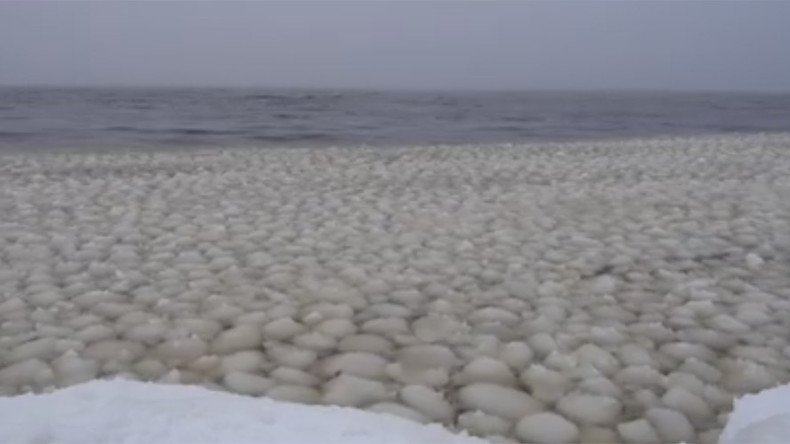‘From another planet’: Waves of strange ‘snowballs’ found in Maine lake (VIDEO)

An artist visiting Maine to take photographs of his stone sculptures encountered waves of “snowballs” on Sebago Lake. Having posted the video of the undulating snow formation on Facebook, it went viral with 174,000 views.
Sculptor David Allen posted the video with the caption: “Waves of snowballs. This was one of the most awesome natural events I have ever seen!” on his Stone Point Studio Facebook page. The footage had nearly 3,000 shares by Tuesday afternoon.
Waves of snowballs. This was one of the most awesome natural events I have ever seen!
Posted by Stone Point Studio on Tuesday, December 29, 2015
“There was NO ice on the lake, so it isn’t lake ice. In fact it has been very warm, right up until we got this snow/sleet/freezing rain storm. It was very cold when I shot this, maybe around 20 degrees,” wrote Allen. He also shared videos and stills of a scene he described as “being from another planet.”
Some other planet.....
Posted by Stone Point Studio on Tuesday, December 29, 2015
The “waves of snowballs” scene was posted to Allen’s page on December 29, and by Tuesday he had over 174,000 views. Though the balls look icy and hard in the video, Allen found they were actually the opposite.
“I fished out a couple of the balls, and sure enough, they broke apart and were very slushy, definitely not ice,” wrote Allen
Colours of Life... for your #fridayfeeling : Mysterious Ice Balls in Lake Michigan https://t.co/fjPdCtQbBqpic.twitter.com/dwC1M7JJun
— Ice Watch Ltd (@IceWatchLtd) December 18, 2015What caused the phenomenon is unknown. One explanation could be El Nino, which is causing haphazard and extreme weather events all over the US and around the world. In the past month, New Mexico received eight to ten feet of snow over a weekend, North Texas received a beating with nine tornadoes in one storm, and California, in its fourth year of drought, received enough snow storms that it looks set to replenish significant amounts of water loss.
Monster winter storm 'Goliath' brings twisters, floods, snow and deaths
https://t.co/KAa7x9bDxlpic.twitter.com/hUXbLNOa70
— RT America (@RT_America) December 29, 2015As for Maine’s mysterious snowballs, a freezing rain storm could have created the conditions for hail to form. Hail forms in storm clouds when cold water droplets freeze on contact with dust or dirt. A storm’s updraft then blows the hailstones to the upper part of the cloud, and when it dissipates the hailstones fall.
At least 14 dead as storms & ice wreak havoc across US Midwest https://t.co/0W6knYWrcJpic.twitter.com/n9ms98Zawi
— RT America (@RT_America) November 30, 2015However, hailstones are tiny in comparison to these football-sized balls. Allen has his own theory.
“My best guess, was that it was SO cold and windy, that when the snow hit the water, it didn’t melt, but instead, remained as slush on the surface. This slush then got stuck in this area, and through wave and wind action, turned into these very uniform balls. That’s all I got!” Allen added on Facebook.
Adding to the Sebago Lake mystery is that is situated inland, so the balls couldn’t have traveled from elsewhere. But Allen is not so far off in his theory for how the snow balls formed.
It is not the first time the unusual snow formation has appeared on lakes and the ocean. The beach ball-sized snowballs were spotted in Lake Michigan near Glen Arbor, Michigan in 2015.
They were also seen earlier in 2013.
Tom Ulrich of Sleeping Bear Dunes National Lakeshore told MinWashington News they are not unprecedented.
"Its not that it never happens and this is a once in a decade thing. It happens more often than that, but these were very large, these got bigger than they usually get," he said about the balls, which were up to up to 50 lbs (22.7 kg) in weight.
Local meteorologists said the balls form because the water in Lake Michigan is just below freezing, causing small pieces of ice to form that get larger as waves move back and forth adding additional water that freezes in layers. They then get pushed onto shore by the wind.
"As these things rub together it is very much like a river rock, a river stone; they get polished and sculpted into that round shape," added Ulrich.
Posting a still from the strange wintry scene, Allen told ABC news, “It was extremely interesting and even awe-inspiring in way words can’t really describe.”
Thanks, Mother Nature, for the art. As per usual, you win!
Posted by Stone Point Studio on Tuesday, December 29, 2015












